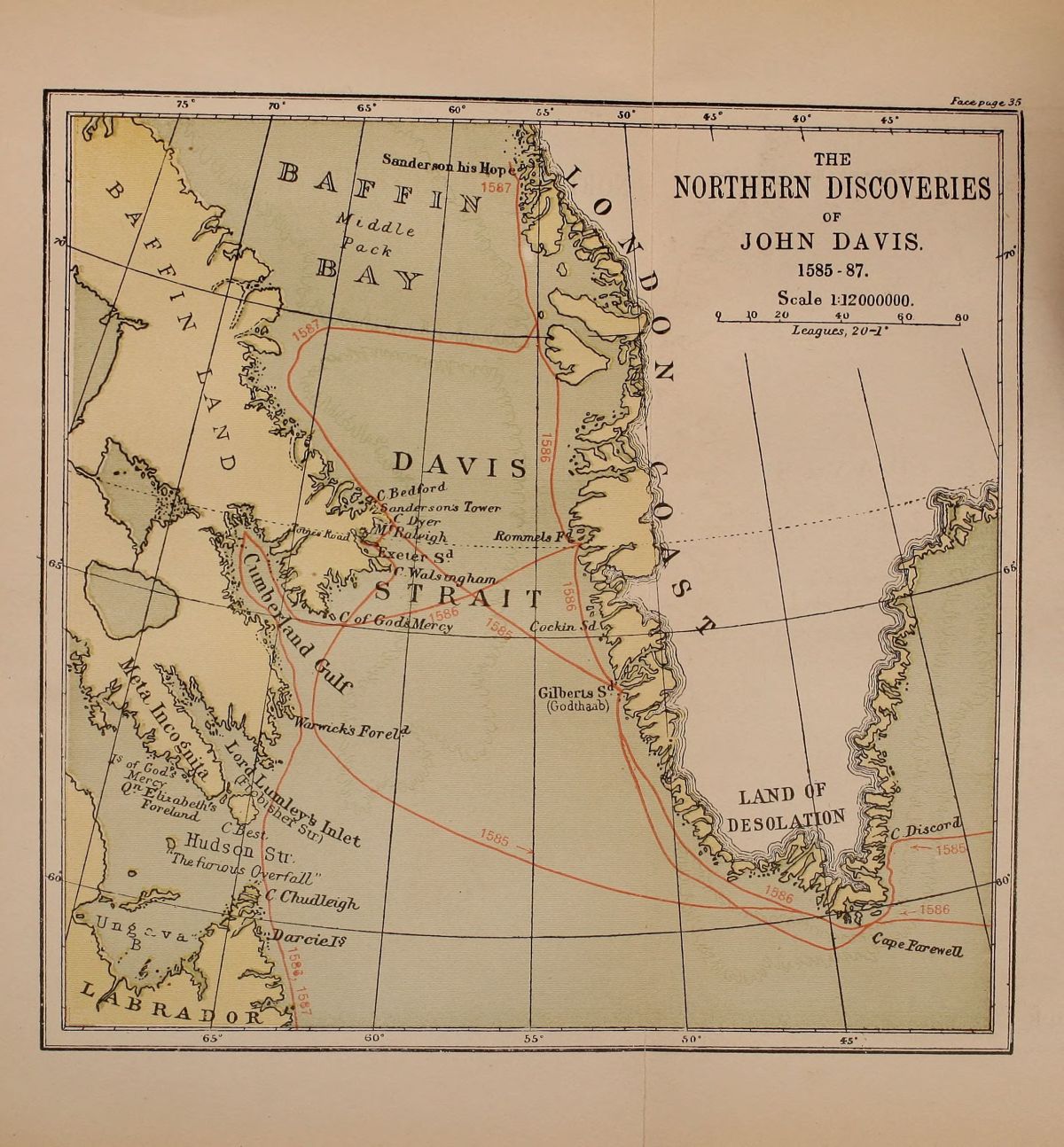Embarking on another significant historical journey, John Davis set sail from Dartmouth on 7 May 1586, leading his second expedition to the Arctic Sea. This voyage, marked by the presence of four ships-the Mermaid (120 tons), Sunshine (60 tons), Moonshine (35 tons), and North Star (10 tons)-would lead to several great adventures.
On the 15th, Davis came in sight of the southern extremity of Greenland, but the pack ice rendered it impossible to land, so Davis named it “Cape Farewell” and continued along the strait that now bears his name. Here, he encountered severe gales of wind, and it was not until the 29th that he again sighted the towering mountains of Greenland near Gilbert Sound. He then took shelter among the islands along the coast and commenced examining the shore.
As his chronicler Jayne tells the story: “… we sent our boats to search for shole water … the people of the country having spied them, came in their canoes towards them with many shoutsand cries … After I perceived their joy … myself with the merchants and others of the company went ashore, bearing with me twenty knives. I had no sooner landed, but they leaped out of their canoes, came running to me and the rest, and embraced us with many signs of hearty welcome: at this present, there were eighteen of them, and to each of them, I gave a knife: they offered skins to me for reward, but I made signs that it was not sold, but given them of courtesy …” (Markham, 1880, p. 16)
The next day, the pinnace was landed on an island for assembly, and while the carpenters got to work, they were surrounded by many Inuit who were again very friendly. Davis records that as many as 100 kayaks came up to the ship at one time and that the Inuit were “very diligent to attend to us, and to help us up the rocks, and likewise down.” (Markham, 1880, p. 17)
The pinnace was launched on 4 July, with forty people helping them. The English were almost constantly surrounded wherever they went by Inuit in their kayaks, and thieving started to become a major problem. One night, the Inuit began firing stones upon a ship with slings, and a large rock knocked down the boatswain of the Moonshine. Davis finally lost his patience and chased after the perpetrators in their kayaks but without success. The next day his crew did manage to capture one of the ringleaders who they hoped to exchange for their anchor. However, the wind came up, and this poor soul was carried out to sea.
As Davis and crew traveled southward of Gilbert Sound, they came upon “an enormous iceberg on the 17th of July. Its extent and height were so extraordinary that the pinnace was sent to ascertain whether it was land or really ice. The report was that it was indeed one gigantic mass of ice, floating on the sea, with bays and capes, plateaus and towering peaks, [which] excited great astonishment.” (Markham, 1889, p. 42)
Soon, masses of ice began to collect around the ships, and the ropes and sails became frozen and covered with ice. Further progress was checked, and the men began to despond, telling the captain: ”That he should regard the safety of his own life and the preservation of his people, and that he should not through over-boldness run the risk of making children fatherless and wives desolate.” (Markham, 1889, pp. 47-48)
At this point, Davis decided to send the Mermaid home with the sick and feeble, while he continued on in the Moonshine. He sailed westward and made land on the opposite side of the strait, near Exeter Sound. Then, sailing southwest, he entered the Cumberland Gulf again, passed the entrance to Hudson Strait without observing it, and sailed along the coast of Labrador. Here, they fished for cod, which they salted to take home.
While they were at anchor, several men were sent on shore to collect some fish which had been laid out on the rocks to cure. Unknown to them, several Mi’kmaq were hiding in the woods, “who sent a murderous round of arrows at the sailors. Seeing this unfold from the boat, Davis sailed towards the shore and discharged his muskets at the savages, which scattered them. Unfortunately, two of his men were killed by arrows, two were seriously wounded, and just one escaped with an arrow wound to the arm, by swimming off toward the ship.” (Markham 1889, p. 56)
Davis and the crew were then caught up in a furious gale that lasted for three days. This proved to be the tipping point for Davis, and he decided to give up and return home. He left for England on 11 September and arrived home in early October 1586.
Illustration: Map showing Davis’s northern voyages. From C. R. Markham’s The life of John Davis, the navigator (1889).
Bibliography
Markham, A. H. (ed.) (1880) The voyages and works of John Davis, the navigator. London: The Hakluyt Society.
Markham, C. R. (1889). The life of John Davis, the navigator (1550 – 1605). Discoverer of the Davis Straits. Dodd Mead and Company, New York.
